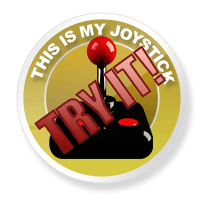Reviews
Metal Gear Solid 3D: Snake Eater
April 27, 2012, Author: Andy Corrigan
I’m going to get this out of the way right off the bat: I have never really been a fan of Metal Gear Solid. If you’re expecting a rose-tinted review that soulfully reminisces about the good old days, I can tell you now that you’re not going to get that here.
If you’re a fan yourself, as many of our own writers are, you’re probably already reaching for your pitchfork, rallying an angry mob and sharpening the pole on which you envisage my head. Yet, I may as well go the whole hog here: Metal Gear Solid 3: Snake Eater has always been my least favourite in the series (MGS1 being my favourite by a country mile, if you’re asking).
It’s a game I’ve played twice before to the halfway point, before labelling it ‘an abortion’ and ‘self-indulgent’. I like Kojima as an industry character, but I can’t help but feel that he’s become imprisoned by his own creation and, at least to me, it seems to have shown increasingly with each passing instalment.
That said, I am always willing to be proven wrong, especially with games held in such high regard.
There are many games, and even entire franchises, that I’d never cared for previously and have grown to adore through subsequent replays (Dead Rising and God of War being noteworthy mentions). While in this instance I’ve found myself reviewing Metal Gear Solid 3D: Snake Eater out of necessity rather than love, I will absolutely approach it once again with an open mind.
If it helps, think of this as less of a review and more as the personal experiment of someone testing the weight of their own opinion… I hope I can finally see what all the fuss is about.
Let’s twist again…
The biggest point of contention for me with Metal Gear Solid has always been its story. I loved the first game, which was complex but self-contained, and knew when to reign itself in. Since then, I’ve felt the series plot has been the dictionary definition of ‘convoluted’, with ridiculous twist after twist, conspiracy theories, double-crosses and laughable dialogue that says a lot without saying anything at all. Unfortunately, my opinion on the quality of writing hasn’t changed all that much after this playthrough, although it nearly had me hooked around the half-way point.
MGS3 is the second Metal Gear Solid game in the series where you don’t play as series hero, Solid Snake, instead taking on the role of Naked Snake (later known as Big Boss) during the Cold War. Snake is dispatched to Tselinoyarsk in the USSR to find and recover a kidnapped scientist named Sokolov, who has been working on a tank capable of launching nukes.
Already posted in the area is Snake’s closest compatriot and mentor, The Boss, who after briefly reuniting with her disciple, decides to defect to a USSR terrorist unit hell-bent on overthrowing the current Premier, Nikita Khrushchev. She offers her new boss, Colonel Volgin, the gift of two stolen nuclear warheads. After securing Sokolov and his tank for himself, Volgin wastes no time in launching one of his new nukes, seeing the US blamed in the process.
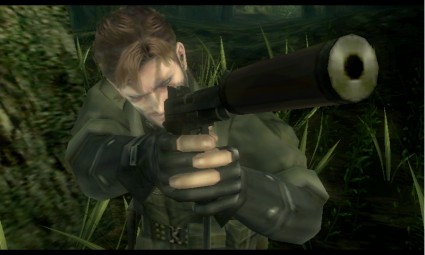
This is where it all began for the family Snake...
With both nations on the cusp of war, the USSR agrees to give the USA a chance prove their innocence by taking out this rogue unit and their new American agent. Snake, now healed after a hefty beating in his last visit, is dispatched once more on the mission codenamed ‘Snake Eater’.
Thankfully, having now finished it, I can see that MGS3 definitely comes across a little more focused than its brothers; however, its pacing in storytelling is all over the place. Its biggest problem is that it throws so much unnecessary information at you in the very beginning and in such a dry manner, that it’s almost impossible to take it all in on the first attempt. The basics are evident: someone close to Snake has defected, he has to kill them or see war break out; however, all the detail in-between can be a little overwhelming at first.
While entirely skippable, the infamous cut-scenes did have a negative impact on gameplay for me, with their frequency driving me to the point of frustration. Every time I was getting into the flow and enjoying slinking around for as little as a few minutes, the game would then jump headfirst into a long, boring cut-scene. Don’t get me wrong, I love cut-scenes as a medium; but after the first few hours of playing, only around 20-30 collective minutes of that time spent was actual gameplay. Not being able to play the game for such a huge length of time is not really a selling point for me, and probably a large part of why I ended up not bothering to see the game through in previous attempts.
As you get to the midway point at least, the pace of pointless information slows greatly and gameplay and story find an almost karmic balance. It becomes coherent and interesting as the plot begins to focus on the characters, and I would even go as far to say that there were times that I became genuinely gripped and invested. It’s also here where the degree of charm in which the game carries itself becomes fully evident, with an admirable amount of self-awareness and a quirky sense of humour shining through. These are both things that go a long way with me.
That unfortunately proved short-lived, as it reverted to the incomprehensible bullcrap right at the death, with double-cross after double-cross. It’s a shame, but it’s just one of those things that Metal Gear does, and you either love this about it, or you don’t.
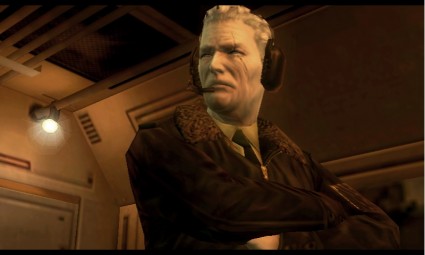
What kind of military officer uses the phrase 'Sneaking Mission'?!
Snakes and ladders…
Thankfully, when the game eventually just allows you to get on with playing, the core gameplay can be an absolute blast.
Naturally, as Snake on a covert operation, your primary weapon is stealth. To progress through the game, you’ll typically have a location that you need to head to with obstacles and patrols in your way, with your intention to remain as invisible as possible throughout. There are a myriad of approaches and routes to take, though; there is no ‘right’ way to play.
Because of the new jungle setting that came in with MGS3, Kojima Productions smartly did away with the previous system of an overhead fixed camera and radar with the enemy’s cone of vision. With this, it feels like a freer, more organic experience, and it helps ramp up the tension.
Instead of using cover and corridors to your advantage, you must use camouflage to successfully hide from the enemy, along with an old-fashioned motion sensor that only displays a guard’s location, and not their direction or visual awareness. Its use is also reliant on battery power, and therefore can be limited if you don’t keep one eye on its capacity.
How visible you are is depicted by a percentage (akin to the original Splinter Cell’s old darkness system) and changing your camouflage to suit each environment and surface is essential if you want to remain unseen. For example, should you be smack bang in the middle of long grass, you can head to the camouflage menu and be provided with a simple guide as to which of the stock designs will best suit your current position. You need to keep on top of this.
New to this 3DS version is the ability to use the console’s camera to create your own camouflage, and while the process takes a tad too long for my liking, it can come up with some fantastic results that in many cases are more effective than the stock options. The picture I took of my workplace toilet floor was somehow awesome for white indoor environments, while the wood grain of my desk proved invaluable for the desert and mountain areas.
The game places a major emphasis on the term ‘survival’ too. Instead of just using a ration to heal as you would previously, healing happens automatically; however, you do have to keep up Snake’s stamina with food if that’s to take place. Low stamina can also affect how quickly Snake can run, and how steady his aim is. To help, you’ll occasionally find food and rations littered around the maps, but you’ll definitely have to supplement them by killing and eating the local wildlife.
Once you slay a helpless animal, an item appears that gets stored in your inventory, and you can then eat it whenever you need. If you don’t feed Snake often enough, his rumbling stomach might just give your position away. Don’t let food stay in your inventory too long either, as it can quickly spoil and might give Snake a bout of stomach ache, which leads us nicely into the next part of surviving: his conditioning.
If you get shot, cut, burnt or bitten by something venomous, you’ll need to take care of it otherwise it’ll have an adverse effect on Snake’s natural ability to heal, or will deplete his stamina at a faster rate. Here you need to use the Cure menu, and take the appropriate course of action to clear Snake of his ailments.
For example, stomach or poison problems can be taken care of with different types of medicine, while leeches can be burned off with his cigar. Bullet wounds require you to use his knife to pop the bullet out, before disinfecting and bandaging the area. Unfortunately it’s all menu based, though; so it’s rather dryly presented, but it’s a cool take on health management.
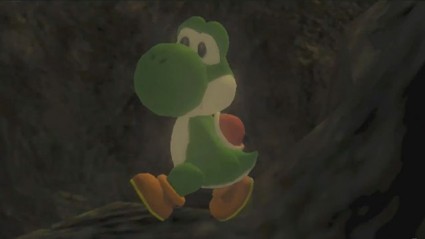
Instead of looking for hidden frogs, you've got hidden Yoshis!
Of course, there are times you’ll need to use weapons and gadgets to your advantage, or fight your way out of a corner when you get spotted, and there have been further, minor improvements made for this 3DS outing. Players will use the now-traditional Left Shoulder button to pull aim, and Right to fire, making the process feel more natural to modern-day players.
Elsewhere, if you play with the standard 3DS controls, the face buttons take charge of camera duties, while the D-Pad performs actions such as reloading, climbing and changing your stance between upright, hunched and prone. Adding the Circle Pad Pro into the mix simply reclaims the face buttons, providing the action buttons a more natural place to sit. Honestly, I spent a good time playing with both setups (with the attachment at home, without at work) and the game runs at a slow enough pace that the Circle Pad Pro is not entirely essential.
Whichever method you favour, the controls might feel ropey and a bit too weightless when compared to modern-day games, and it can certainly hamper some of the earlier enjoyment. It’s nothing some persistence (or in my case, tampering with the game’s sensitivity levels) can’t fix, though. They’ve always had that element of clumsiness to them with certain quirks; it just means that it hasn’t aged quite so well in this respect.
That becomes more evident when you are in free combat, though, and the game also shows some further limitations, especially with A.I.. When guards go into full alert and they know where you are, their intelligence proves erratic. You see them aimlessly run around you, sometimes ignoring you completely, sometimes facing the wrong direction, and never seeking cover when under fire. Take one guard out with a gun while another is in earshot, and they’ll all head to your direction Benny Hill style, despite the fact you’re gunning them down from your position. Until you get overwhelmed, that is.
Don’t get me wrong, when you’re hidden and they don’t know where you are, A.I. is brilliant; looking under gaps and tight spaces, investigating the noise you’re making, leading to incredibly tense gameplay with an element of unpredictability. As soon as they spot you for definite, it can look awfully messy as you make your getaway.
The boss fights are a different matter entirely, though, and combat finesse is essential. Like most bosses these days, they’re pretty formulaic and once you know the patterns of attack, you should dispense with them fairly easily. Except for one.
The long, drawn out sniper battle against ‘The End’ in a vast jungle arena has just about become my favourite boss fight of all time. Slow paced, yes, but intensely exhilarating in a way that no action game could ever manage, and there were a multitude of ways I could have tackled it. I want to talk at length about this, but I won’t and I don’t want to spoil it for anyone.
While I can take or leave some of MGS3’s other aspects, this fight turned out to be the highlight of the game for me, and it’s the one element out of everything that made me happy that I’d given it this a third chance to win me over.
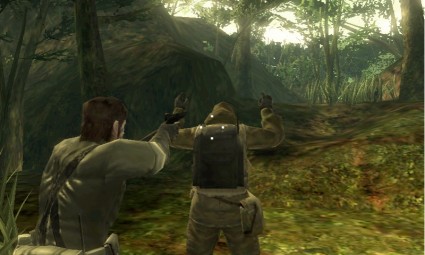
There are tons of imaginative ways to outsmart the guards!
Camouflage capers
In many respects, Snake Eater on 3DS is right up there alongside the best the system has to offer in terms of its visual output, though there are a few hiccups. The frame rate was the main offender, with a noticeable stagger here and there, particularly during cut-scenes. The draw distance is also painfully short, with immediate shrubbery drawing itself in with every single forward movement. These are very minor gripes as it still looks lovely in motion, and your eyes will soon adjust to the point where neither is even noticeable.
The 3D effect is phenomenal, however, and is probably one of the best showcases for 3D entertainment I’ve seen thus far. From the very first cut-scene where Snake glibly flicks his cigar towards the camera, it felt like it was popping right out of the screen. As well as the 3D has been used in certain other titles, it’s the first time I’ve seen it used to that effect on 3DS, where I almost felt I could physically touch certain elements. A surprising aspect to a port that otherwise needed little work.
Junglist movement
Sorry David Hayter fans, I know the man has cult status for his cheesy delivery, but I’ve always hated Snake’s pseudo-macho voice and nothing has changed my mind here. There’s a lot to love elsewhere with other vocal performances, though, in spite of the hokum-driven script. Josh Keaton as a young and easily frustrated Ocelot was one of the highlights, while Neil Ross sold his villainous alter-ego of Volgin pretty damn well.
The jungle theme is also nicely represented audibly, with the sounds of wildlife, foliage rustling and running water sources adding much weight to this new setting. Everything else is typically Metal Gear, though, from the soundtrack that just about fits the espionage story, to the arcade-style sound effects of kills, item pick-ups and soldier’s alerts. Everything is intact from previous releases; fans will simply find no surprises.
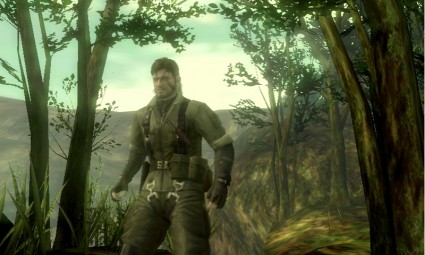
Make sure you're camouflaged well!
Snaking my way out of it
While I stop just short of being fully won over by the Metal Gear Solid 3 experience, I do have to admit that I was a lot more receptive to it this time around. I still dislike the game’s incessant need to bombard the player with lengthy and pointless cut-scenes (especially early on) and I still find the plot painfully intolerable even now having seen its conclusion. Fans, however, will see these aspects as part of the fun, and I can’t really complain if that’s their bag. It’s just not something that’s ever resonated for me within this series, and I doubt it ever will.
What I found eventually, though, was a game that I warmed to the more I played; a game where its best moments came when stripped back to basics. When it’s just you in the jungle with a destination and an army of patrolling guards in your way, there are few other games that can touch it in terms of pure, unnerving tension. Getting through an area unseen and using the tools at your disposal is undeniably exciting; I just wish the game had more of those moments in place of the self-indulgent tosh in-between.
If you’re a series fan with a 3DS, then you should absolutely buy this without hesitation; you’ll find a true little port that you can carry around in your pocket. For everyone else, it might be still worth a punt depending on your mindset.
Me? While I didn’t quite have the extreme turnaround I was hoping for, I might just have to give that HD Collection a go, to see if I can be sold any further…
Platforms: 3DS | Tagged Big Boss, Hideo Kojima, Kojima Productions, Liquid Snake, Metal Gear Solid, Metal Gear Solid 3 Snake Eater, MGS, Snake Eater, Solid Snake, Stealth


